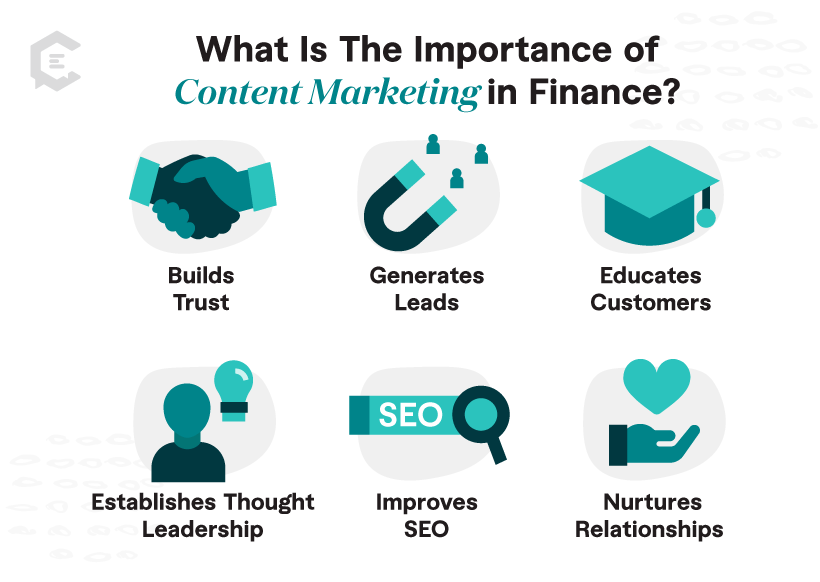Finance writing can not only sway readers to convert. It can seriously affect their wallets, businesses, and quality of life.
Employing the right content marketing for financial institution tactics is vital. Learn more about finance content marketing strategies to boost engagement and the bottom line.
The Importance of Content Marketing in Finance
Finance content marketing enables businesses to:
- Build trust
- Generate leads
- Educate customers
- Establish thought leadership
- Improve SEO
- Nurture relationships
It’s a powerful strategy for connecting with your target audience. Successful content marketing can help you stand out from competitors and drive growth in the finance industry.
However, when planning a content strategy for financial institutions, some key considerations exist. Financial advice can have a real impact on readers’ lives.
Google lumps finance content with other important topics like health and safety. As part of the Medic Update in 2018, Google imposed more stringent guidelines for financial content. These guidelines are important for SEO efforts. Plus, it acts as a reminder that authority and trust are key for this type of content marketing.
Here are some strategies to follow to ensure content marketing success in the financial sector:
Strategy 1: Creating Targeted Content
Marketing strategies for fintech companies can be a challenge. It’s hard to stand out, gain customers’ trust, and navigate regulatory concerns simultaneously.
The path to success requires a deep understanding of the target audience.
With a big umbrella of “finance,” it can be tempting to write anything and everything. However, staying on topic is vital to financial content marketing.
To create targeted content:
- Take a deep look at your audience
- Try to understand users’ needs, struggles, and behavior
- Tailor content to your specific user
And if you need help, we’ve got some great financial content ideas to inspire you.
Case study: Chime’s success with audience-first content
Digital bank Chime has found success with younger audiences thanks to its content marketing strategy. Chime offers debit cards without monthly service fees, minimum balance requirements, and overdraft fees.
Chime’s blog content puts the customer at the forefront.
In an interview, Chime CEO, Chris Britt, said that they take the time to understand their target audience’s preferences and pain points. Only then do they make any product or service-related decisions. This ensures that their fintech marketing plan aligns with audience needs.
Strategy 2: SEO Optimization for Finance Content
Creating and optimizing content for search engines can significantly enhance a business’s online visibility. This is still the case in the finance sector.
Businesses can increase their chances of ranking higher in search engine results by:
- Using relevant keywords
- Addressing common search queries
- Following SEO best practices
Financial services providers can gain a lot with SEO and strong keywords. A strong SEO strategy for finance can improve visibility, drive leads, and improve branding.
To implement an SEO content strategy, look for keywords relevant to your audience and write content meant to rank.
There are tons of ways to rank better on Google, so start with some SEO fundamentals:
- Perform keyword research: When planning content, map it to one or more keywords people are searching for
- Write clearly: Incorporate keyword phrases naturally into content
- Incorporate links: The way you link your pages internally tells search engines which pages you value. Also, what information those pages contain
Case study: SEO success in the finance industry
German-founded fintech company Penta used SEO to double traffic and gain 55% more leads in 15 months.
According to SEMrush, Penta used blog posts and glossaries to drive traffic to the site. Once users visited the site to learn more about banking terms and more generic topics, they would follow internal links and buttons to product pages to drive conversions.
Strategy 3: Video Marketing for Financial Services
Of all the financial content types to use, one of the most effective ways for financial service firms to connect with customers is through video. Videos are engaging and educational, encouraging consumers to act. Nearly three-quarters of consumers prefer to learn about products and services through video.
When incorporating video into your content strategy, look for ways to educate your audience. Video can help introduce new concepts, personalize experiences, or humanize your brand.
Case study: A financial institution’s success with video marketing
Global payment giant Visa successfully used videos to connect with decision-makers in Asia. Visa launched a newsroom of engaging videos. VisaAPnews.asia covered topics like economics. These videos drove business, viewpoints, and innovation.
These engaging videos helped Visa garner high levels of engagement and clicks.
- 250% increase in click-through-rate
- 95% increase in daily visitors
- 75,000 daily active users
Strategy 4: Personalization in Finance Marketing
Personalization in content marketing refers to tailoring content and messaging to your audience. Personalized content should meet individual users’ specific needs, preferences, and characteristics. Remember, poor understanding of a target audience is one of the most common pitfalls in financial content marketing.
One great place to use personalization is email.
Businesses can personalize email content, subject lines, and CTA by leveraging subscriber data. Personalized emails have higher open, click-through, and conversion rates than generic mass emails.
Just remember to consistently measure your finance content marketing to ensure success.
Case study: Implementing personalization successfully
Ally Financial used personalization to drive new product adoption.
Ally used personalized emails aimed at cross-selling mortgage and investment products to existing customers. Through AI, Ally could tweak email language to different audience segments, making the content feel tailor-made.
Ally saw 57% new product adoption after launching their personalization campaign.
Create Content for Financial Services
Finance can be complex and intimidating for many people. Content marketing provides an opportunity for finance businesses to speak clearly.
Quality content can:
- Simplify complex concepts
- Explain industry trends
- Offer practical advice
With good content, businesses can empower customers to make informed financial decisions. This, in turn, can lead to increased customer loyalty and satisfaction.
Creating financial content requires experience, care, and talent.
If you’re looking for writers to help with a content marketing strategy for finance, ClearVoice can help. We can pair you with financial content writers who match your needs and budget to produce high-quality financial content that drives success. Talk to a content strategist today to see how.








